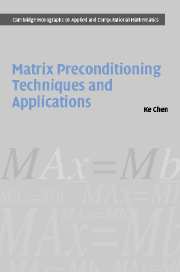Book contents
- Frontmatter
- Contents
- Preface
- Nomenclature
- 1 Introduction
- 2 Direct methods
- 3 Iterative methods
- 4 Matrix splitting preconditioners [T1]: direct approximation of An×n
- 5 Approximate inverse preconditioners [T2]: direct approximation of An×n−1
- 6 Multilevel methods and preconditioners [T3]: coarse grid approximation
- 7 Multilevel recursive Schur complements preconditioners [T4]
- 8 Sparse wavelet preconditioners [T5]: approximation of Ãn×n and Ãn×n−1
- 9 Wavelet Schur preconditioners [T6]
- 10 Implicit wavelet preconditioners [T7]
- 11 Application I: acoustic scattering modelling
- 12 Application II: coupled matrix problems
- 13 Application III: image restoration and inverse problems
- 14 Application IV: voltage stability in electrical power systems
- 15 Parallel computing by examples
- Appendix A a brief guide to linear algebra
- Appendix B the Harwell–Boeing (HB) data format
- Appendix C a brief guide to MATLAB®
- Appendix D list of supplied M-files and programs
- Appendix E list of selected scientific resources on Internet
- References
- Author Index
- Subject Index
- Plate section
9 - Wavelet Schur preconditioners [T6]
Published online by Cambridge University Press: 06 January 2010
- Frontmatter
- Contents
- Preface
- Nomenclature
- 1 Introduction
- 2 Direct methods
- 3 Iterative methods
- 4 Matrix splitting preconditioners [T1]: direct approximation of An×n
- 5 Approximate inverse preconditioners [T2]: direct approximation of An×n−1
- 6 Multilevel methods and preconditioners [T3]: coarse grid approximation
- 7 Multilevel recursive Schur complements preconditioners [T4]
- 8 Sparse wavelet preconditioners [T5]: approximation of Ãn×n and Ãn×n−1
- 9 Wavelet Schur preconditioners [T6]
- 10 Implicit wavelet preconditioners [T7]
- 11 Application I: acoustic scattering modelling
- 12 Application II: coupled matrix problems
- 13 Application III: image restoration and inverse problems
- 14 Application IV: voltage stability in electrical power systems
- 15 Parallel computing by examples
- Appendix A a brief guide to linear algebra
- Appendix B the Harwell–Boeing (HB) data format
- Appendix C a brief guide to MATLAB®
- Appendix D list of supplied M-files and programs
- Appendix E list of selected scientific resources on Internet
- References
- Author Index
- Subject Index
- Plate section
Summary
There seem to be at least two important issues for which wavelet-like expansions have already proven to work with great success, namely preconditioning linear systems stemming from Galerkin approximations for elliptic problems and compressing full stiffness matrices arising in connection with integral or pseudodifferential operators, to facilitate nearly optimal complexity algorithms for the solution of the corresponding discrete problems.
Wolfgang Dahmen, et al. Multiscale methods for pseudodifferential equations. Recent Advances in Wavelet Analysis (1994)In the usual FEM setting, Schur complement methods from Chapter 7 perform the best if there is some kind of ‘diagonal’ dominance. This chapter proposes two related and efficient iterative algorithms based on the wavelet formulation for solving an operator equation with conventional arithmetic. In the new wavelet setting, the stiffness matrix possesses the desirable properties suitable for using the Schur complements. The proposed algorithms utilize the Schur complements recursively; they only differ in how to use coarse levels to solve Schur complements equations. In the first algorithm, we precondition a Schur complement by using coarse levels while in the second we use approximate Schur complements to construct a preconditioner. We believe that our algorithms can be adapted to higher dimensional problems more easily than previous work in the subject.
- Type
- Chapter
- Information
- Matrix Preconditioning Techniques and Applications , pp. 340 - 363Publisher: Cambridge University PressPrint publication year: 2005

